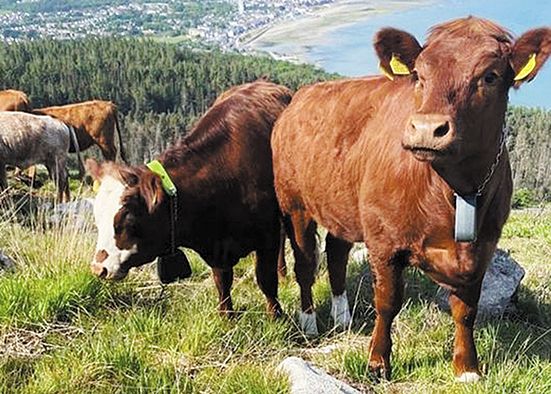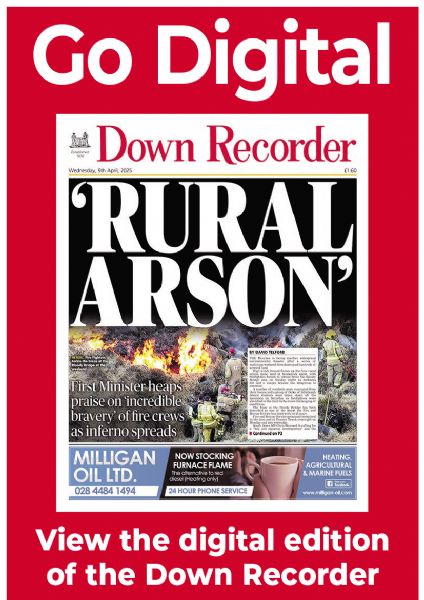Cows to help in Mournes recovery
Cows to help in Mournes recovery
21 June 2023

OVER two years after a devastating wildfire ripped through the Mournes leaving a trail of environmental destruction in its wake, work is continuing to help the precious habitat recover.
An estimated 900 acres of land was destroyed with the scars left in an area of outstanding natural beauty by one of the biggest gorse fires in living memory in Northern Ireland expected to take many years to heal.
Huge flames fanned by winds and difficult terrain presented firefiighters with significant challenges as they worked around the clock to save as much of a landscape teaming with life as they could during what was a complex operation in May 2021.
Some firefighters had to travel up to an hour on foot to reach the blaze carrying their equipment with small pumps used to drain water from rivers and other small pockets of water that they could find.
Firefighters also used back pack sprayers but the majority had to use shovels and beaters to tackle the fire in harsh conditions.
The environmental impact of the blaze — which could be seen up to 20 miles away — is immeasurable with work continuing on a major conservation restoration programme.
National Trust officials who surveyed the scale of the damage in the immediate aftermath of the malicious blaze said they never saw anything like it before, describing parts of the mountain range as resembling a “lunar landscape”, estimating that the once rich habitat could take up to five years to recover.
The organisation is at the heart of the operation to help the scorched land recover and in addition to introducing a small herd of traditional cattle in the Mournes, the National Trust recently embarked on epic helicopter lifting mission to restore and protect the breathtaking beauty of the Mournes, with the work involving transporting essential fencing material to areas devastated by the 2021 wildfire and overgrazing impacts.
The small herd of cattle has been located in the Mournes to help bring wildlife back to Northern Ireland’s highest peaks following the devastating fire two years ago which destroyed an area once brimming with flora and fauna. A huge swathe of vegetation was destroyed and species diversity reduced.
Since then, rangers have been trialling different methods to rejuvenate the land and bring it back to full health for the plants and animals that live there.
Now, working in partnership with a tenant farmer, a herd of Luing cattle has been added to the restoration efforts.
The herd of six cows will trample bracken and chomp through the dominant purple moor-grass that has sprung up since the fire, providing the space for native plants and heather to return, and creating habitat for newts, lizards, ground-nesting birds and hares.
And the animals will wear special collars with GPS tracking which allows ‘virtual fences’ to be created.
The National Trust explained this means grazing can be targeted at particular areas of the mountains without the need for intrusive fences, while maintaining high levels of animal welfare.
It says the innovative ‘no fence technology’ has been shown to be an effective tool to deliver targeted conservation grazing management.
National Trust officials describe the project as a “fantastic example” of working to deliver a natural solution through the reintroduction of traditional cattle and use of technology to showcase that farming has a vital role to play in tackling the nature and climate crisis.
In relation to the helicopter lifts, the Trust explained the areas devastated by the wildfire “hold the key to preserving and nurturing the precious habitats that make this mountain range so unique”.
The organisation explained that as part of its ongoing commitment to safeguarding the natural wonders of the Mournes, it’s constructing small grazing exclosures in these particular areas.
Detailing the scale of its work on the mountains on social media, the Trust said the exclosures serve as sanctuaries for nature, allowing the habitat to recover and flourish without the pressures of grazing.
“These exclosures also serve as vital observation points, enabling us to closely monitor the magnificent recovery of the ecosystem as grazing pressure decreases. It’s a remarkable opportunity to witness the magic of nature’s resilience in action,” the Trust continued.
“We owe a huge thanks to our incredible team and the helicopter pilots who fearlessly navigated the skies, ensuring that every piece of fencing material found its rightful place. It’s their dedication and passion for conservation that fuels these awe-inspiring efforts.”
The Trust has also expressed its “deepest gratitude” to the generations of donors and members who have supported the organisation throughout the years.
“This important work would not be possible without the generous contributions and memberships from all our valued visitors. Your support enables us to continue preserving the Mournes for future generations,” the social media post continued.
“Together, we’re making a difference and shaping a brighter future for the Mournes.”


